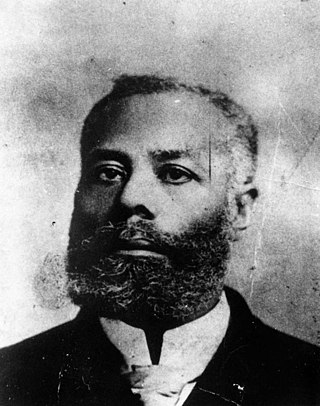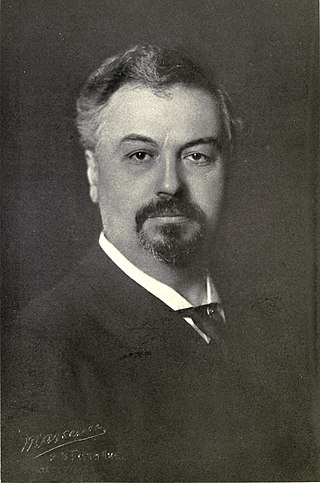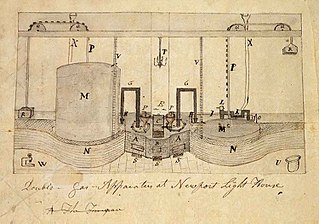Related Research Articles

Thomas Alva Edison was an American inventor and businessman. He developed many devices in fields such as electric power generation, mass communication, sound recording, and motion pictures. These inventions, which include the phonograph, the motion picture camera, and early versions of the electric light bulb, have had a widespread impact on the modern industrialized world. He was one of the first inventors to apply the principles of organized science and teamwork to the process of invention, working with many researchers and employees. He established the first industrial research laboratory.

George Westinghouse Jr. was an American entrepreneur and engineer based in Pennsylvania who created the railway air brake and was a pioneer of the electrical industry, receiving his first patent at the age of 19. Westinghouse saw the potential of using alternating current for electric power distribution in the early 1880s and put all his resources into developing and marketing it. This put Westinghouse's business in direct competition with Thomas Edison, who marketed direct current for electric power distribution. In 1911 Westinghouse received the American Institute of Electrical Engineers's (AIEE) Edison Medal "For meritorious achievement in connection with the development of the alternating current system". He founded the Westinghouse Electric Corporation in 1886.

The National Inventors Hall of Fame (NIHF) is an American not-for-profit organization, founded in 1973, which recognizes individual engineers and inventors who hold a U.S. patent of significant technology. Besides the Hall of Fame, it also operates a museum in Alexandria, Virginia, sponsors educational programs, and a collegiate competition.

Sir Joseph Wilson Swan FRS was an English physicist, chemist, and inventor. He is known as an independent early developer of a successful incandescent light bulb, and is the person responsible for developing and supplying the first incandescent lights used to illuminate homes and public buildings, including the Savoy Theatre, London, in 1881.

Elijah J. McCoy was a Canadian-American engineer of African-American descent who invented lubrication systems for steam engines. Born free on the Ontario shore of Lake Erie to parents who fled enslavement in Kentucky, he traveled to the United States as a young child when his family returned in 1847, becoming a U.S. resident and citizen. His inventions and accomplishments were honored in 2012 when the United States Patent and Trademark Office named its first regional office, in Detroit, Michigan, the "Elijah J. McCoy Midwest Regional Patent Office".

Emile Berliner originally Emil Berliner, was a German-American inventor. He is best known for inventing the lateral-cut flat disc record used with a gramophone. He founded the United States Gramophone Company in 1894; The Gramophone Company in London, England, in 1897; Deutsche Grammophon in Hanover, Germany, in 1898; and Berliner Gram-o-phone Company of Canada in Montreal in 1899. Berliner also invented what was probably the first radial aircraft engine (1908), a helicopter (1919), and acoustical tiles (1920s).

Elihu Thomson was an American engineer and inventor who was instrumental in the founding of major electrical companies in the United States, the United Kingdom and France.

Elmer Ambrose Sperry Sr. was an American inventor and entrepreneur, most famous for construction, two years after Hermann Anschütz-Kaempfe, of the gyrocompass and as founder of the Sperry Gyroscope Company. He was known as the "father of modern navigation technology".

Oscar Hammerstein I was a German-born businessman, theater impresario, and composer in New York City. His passion for opera led him to open several opera houses, and he rekindled opera's popularity in America. He was the grandfather of American playwright/lyricist Oscar Hammerstein II and the father of theater manager William Hammerstein and American producer Arthur Hammerstein.

Gas lighting is the production of artificial light from combustion of a fuel gas such as hydrogen, methane, carbon monoxide, propane, butane, acetylene, ethylene, coal gas or natural gas. The light is produced either directly by the flame, generally by using special mixes of illuminating gas to increase brightness, or indirectly with other components such as the gas mantle or the limelight, with the gas primarily functioning as a heat source for the incandescence of the gas mantle or lime.

Charles Francis Brush was an American engineer, inventor, entrepreneur, and philanthropist.

Events from the year 1837 in the United States.

The Sneath Glass Company was an American manufacturer of glass and glassware. After a brief 1890s startup in Tiffin, Ohio, the company moved to Hartford City, Indiana, to take advantage of the Indiana Gas Boom. The small city was enjoying the benefits of the boom, and could provide natural gas as an energy source for manufacturers. Sneath Glass was one of many glass manufacturers that moved to the region, and became Hartford City's second largest employer.

Mary Engle Pennington was an American bacteriological chemist, food scientist and refrigeration engineer. She was a pioneer in the preservation, handling, storage and transportation of perishable foods and the first female lab chief at the U.S. Food and Drug Administration. She was awarded 5 patents, received the Notable Service Medal from President Herbert Hoover and the Garvin-Olin Medal from the American Chemical Society. She is an inductee of the National Inventor's Hall of Fame, the National Women's Hall of Fame and the ASHRAE Hall of Fame.

A timeline of United States inventions (1890–1945) encompasses the ingenuity and innovative advancements of the United States within a historical context, dating from the Progressive Era to the end of World War II, which have been achieved by inventors who are either native-born or naturalized citizens of the United States. Copyright protection secures a person's right to his or her first-to-invent claim of the original invention in question, highlighted in Article I, Section 8, Clause 8 of the United States Constitution which gives the following enumerated power to the United States Congress:
To promote the Progress of Science and useful Arts, by securing for limited Times to Authors and Inventors the exclusive Right to their respective Writings and Discoveries.
Pincus or Pinkus is a surname of Jewish origin, derived from the given name Pinkus, which in turn originates with the Biblical Hebrew male personal name Pinechas or Phinehas. The name may refer to:
The following is a timeline of the history of the city of Philadelphia, Pennsylvania.

Rudolph Melville Hunter was an American inventor, engineer, patent attorney and entrepreneur. Hunter was granted 299 US patents, over 140 of them for electric railway apparatus. He played a key role in the development of "mixed control," long the standard method of controlling the speed of electric streetcars and locomotives. Hunter later largely abandoned his work as a practical inventor and devoted himself to a futile quest to transmute silver and other metals into gold.

David Melville was an American inventor, credited with the first gas street lighting in America, and the first American patent for gas lighting.

Arthur Otis Granger was an American industrialist and soldier. He manufactured and installed gasworks in Philadelphia and served as general manager of the United Gas Improvement Company, before serving as president of multiple fuel and gas light companies in the United States and Canada. He was later a mining engineer and railroad executive, and was reported to be a millionaire as of 1889. He established the Etowah Iron Company in Bartow County, had mining interests in South America, and was a business partner to Joseph M. Gazzam.
References
- 1 2 3 4 5 "Obituary: S. Henry Pincus". Variety . Vol. XXXVIII, no. 1. March 3, 1915.
- 1 2 3 Henry Samuel Morais (1894). The Jews of Philadelphia: Their History from the Earliest Settlements to the Present Time; a Record of Events and Institutions, and of Leading Members of the Jewish Community in Every Sphere of Activity. Levytype Company. p. 356, 384.
- ↑ Weldon B. Durham (1986). American Theatre Companies, 1749-1887. Bloomsbury Academic. p. 326.
- ↑ Official Gazette of the United States Patent Office. United States Patent and Trademark Office. January 11, 1881.
- ↑ "The Proceedings of the American Gas Light Association, 26th Annual Meeting". XV. December 1898: ci.
{{cite journal}}: Cite journal requires|journal=(help)